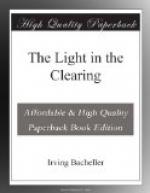It seemed as if all the clouds in the sky were falling to the ground and stacking into a great, fleecy cover as dry as chaff.
We were there where the road drops into a rocky hollow near the edge of Butterfield’s woods. They used to call it Moosewood Hill because of the abundance of moosewood around the foot of it. How the thought of that broken wheel smote me! It was our only heavy wagon, and we having to pay the mortgage. What would my uncle say? The query brought tears to my eyes.
I unhitched and led my horses up into the cover of the pines. How grateful it seemed, for the wind was slack below but howling in the tree-tops! I knew that I was four miles from home and knew, not how I was to get there. Chilled to the bone, I gathered some pitch pine and soon had a fire going with my flint and tinder. I knew that I could mount one of the horses and lead the other and reach home probably. But there was the grist. We needed that; I knew that we should have to go hungry without the grist. It would get wet from above and below if I tried to carry it on the back of a horse. I warmed myself by the fire and hitched my team near it so as to thaw the frost out of their forelocks and eyebrows. I felt in my coat pockets and found a handful of nails—everybody carried nails in one pocket those days—and I remember that my uncle’s pockets were a museum of bolts and nuts and screws and washers.
The idea occurred to me that I would make a kind of sled which was called a jumper.
So I got my ax out of the wagon and soon found a couple of small trees with the right crook for the forward end of a runner and cut them and hewed their bottoms as smoothly as I could. Then I made notches in them near the top of their crooks and fitted a stout stick into the notches and secured it with nails driven by the ax-head. Thus I got a hold for my evener. That done, I chopped and hewed an arch to cross the middle of the runners and hold them apart and used all my nails to secure and brace it. I got the two boards which were fastened together and constituted my wagon seat and laid them over the arch and front brace. How to make them fast was my worst problem. I succeeded in splitting a green stick to hold the bolt of the evener just under its head while I heated its lower end in the fire and kept its head cool with snow. With this I burnt a hole in the end of each board and fastened them to the front brace with withes of moosewood.
It was late in the day and there was no time for the slow process of burning more holes, so I notched the other ends of the boards and lashed them to the rear brace with a length of my reins. Then I retempered my bolt and brought up the grist and chain and fastened the latter between the boards in the middle of the front brace, hitched my team to the chain and set out again, sitting on the bags.
It was, of course, a difficult journey, for my jumper was narrow. The snow heaped up beneath me and now and then I and my load were rolled off the jumper. When the drifts were more than leg deep I let down the fence and got around them by going into the fields. Often I stopped to clear the eyes of the horses—a slow task to be done with the bare hand—or to fling my palms against my shoulders and thus warm myself a little.




